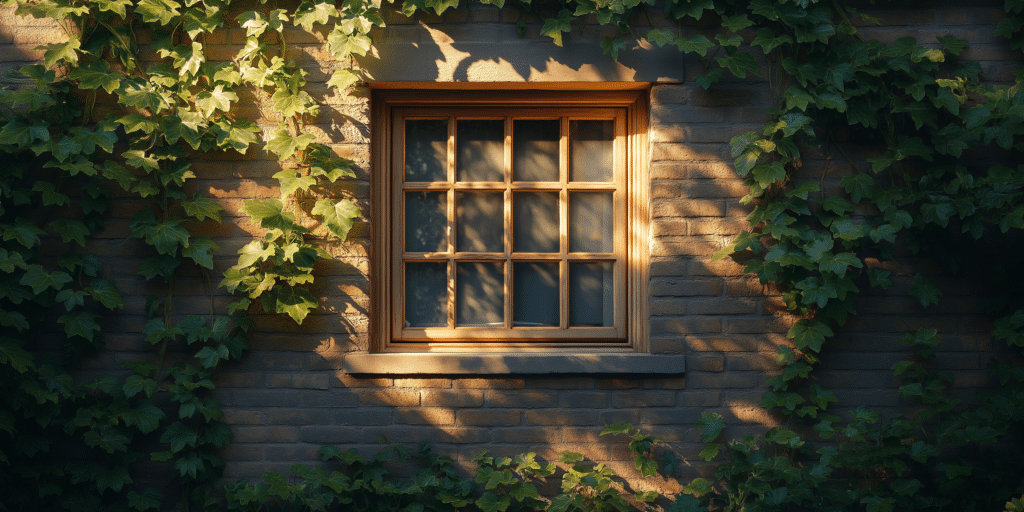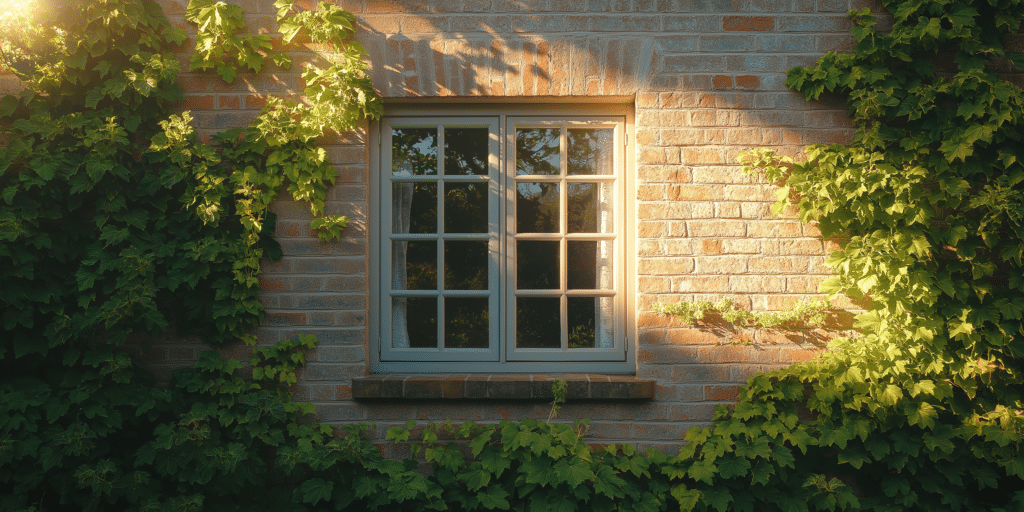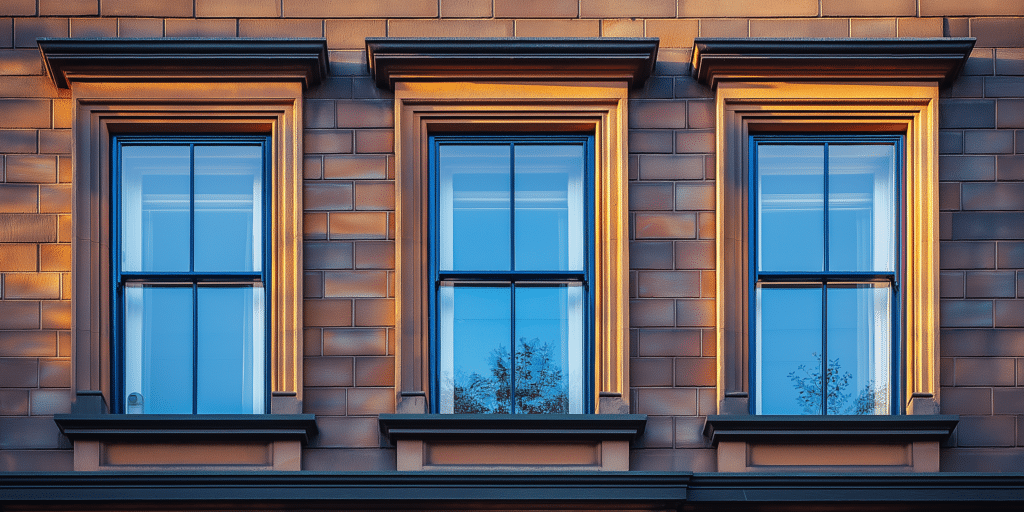Introduction to Sash Windows and Equal Sight Line

Sash windows are a traditional style of window, characterised by one or more movable panels, or “sashes,” that slide vertically or horizontally to open. The concept of an equal sight line is crucial in sash window design, ensuring that the visual lines of all window elements align perfectly, creating a harmonious and balanced appearance. A well-aligned sight line is especially important in maintaining the architectural integrity and aesthetic appeal of both modern and historical buildings.
Compared to modern window designs, sash windows with equal sight lines offer a unique combination of historical authenticity and modern functionality. They preserve the traditional appearance while incorporating modern features like double glazing and enhanced thermal efficiency. The e-architect highlights how sash windows, particularly those from the Georgian and Victorian eras, have benefited from the inclusion of equal sight lines to maintain their timeless elegance.
Historically, equal sight lines have been a hallmark of well-crafted sash windows, reflecting the careful attention to detail in period architecture. In restoration projects, maintaining these sight lines is critical to preserving the building’s original character. The introduction of equal sight lines in the 18th century was a significant evolution in sash window design, contributing to the architectural precision and aesthetic appeal that is still valued today.
Understanding the Concept of Equal Sight Line in Sash Windows
In the context of sash windows, an equal sight line refers to the alignment of the window’s glazing bars, frames, and sashes so that they appear symmetrical and balanced when viewed from the outside. This creates a visually pleasing uniformity that is crucial in maintaining the traditional aesthetic of sash windows.
Achieving an equal sight line involves precise engineering and craftsmanship. The sashes and frames must be carefully measured and aligned during manufacturing and installation to ensure that all visual lines match perfectly. This often requires custom-made components to fit the specific dimensions and design of the window. Ensuring equal sight lines in sash windows necessitates meticulous attention to detail during the design and installation process, which is crucial for both functionality and appearance.
What are the key differences between windows with equal sight lines and those without?
Windows without equal sight lines can appear disjointed or unbalanced, disrupting the symmetry of the building’s facade. In contrast, windows with equal sight lines provide a seamless and harmonious appearance, enhancing the overall aesthetic appeal of the property. The difference lies in the visual impact; equal sight lines offer a clean, unified look that is often required for maintaining the historical accuracy of period properties.
From a functional perspective, equal sight lines contribute to the proper operation of sash windows, ensuring that all components fit and move smoothly. Aesthetically, they ensure that the window looks consistent and well-proportioned, which is especially important in historic buildings. Maintaining equal sight lines is essential for both the visual appeal and functional integrity of sash windows, particularly in preserving the architectural balance of older buildings.
The Benefits of Equal Sight Line in Sash Windows
- Equal sight lines contribute significantly to the visual appeal of sash windows by creating a balanced and symmetrical look. This alignment is especially important in properties with multiple windows, where inconsistency can detract from the building’s overall appearance. By maintaining equal sight lines, the aesthetic integrity of both historical and contemporary structures is preserved, offering a visual continuity that enhances curb appeal.
- Practically, equal sight lines ensure that all parts of the window align perfectly, which can reduce wear and tear on the components. This alignment also ensures that the windows open and close smoothly, improving their functionality and longevity. Properly aligned windows also prevent drafts and leaks, contributing to the overall energy efficiency of the building. Correct weight balance and alignment are crucial for the smooth operation of sash windows, directly impacting their functionality and durability.
- By ensuring that all components fit together perfectly, equal sight lines help reduce gaps and drafts, contributing to better insulation. This, in turn, enhances the energy efficiency of the building, helping to maintain a consistent indoor temperature and reducing energy costs. The use of modern materials, such as low-E glass and thermally broken frames, further improves insulation while preserving the aesthetic benefits of equal sight lines.
- Maintaining equal sight lines in historical buildings is crucial for preserving their architectural integrity. It ensures that any restorations or replacements are in keeping with the building’s original design, which is often a requirement for listed properties. According to experts, maintaining equal sight lines is essential for ensuring that restoration projects meet the stringent requirements of historic preservation standards.
Design and Aesthetic Considerations for Equal Sight Line

Architects and designers incorporate equal sight lines into modern sash window designs by ensuring that the visual lines of all components align perfectly. This often involves using advanced CAD software to plan the window design and ensure precision during manufacturing. The integration of equal sight lines into modern designs allows for a blend of traditional aesthetics with contemporary performance standards, meeting the needs of both historical restorations and new constructions.
What are the aesthetic implications of using equal sight lines in various architectural styles?
Equal sight lines are particularly important in traditional architectural styles, such as Georgian, Victorian, and Edwardian, where symmetry and proportion are key design principles. However, they can also enhance modern architectural styles by providing a clean, uniform appearance. The use of equal sight lines in modern architecture can create a sense of harmony and balance, contributing to the overall visual appeal of the building.
The equal sight line plays a critical role in ensuring that the building’s facade looks symmetrical and balanced. This is particularly important in buildings with multiple windows, where inconsistent sight lines can create a jarring and unbalanced appearance. Maintaining equal sight lines is essential for preserving the visual harmony of a building’s exterior, particularly in historical properties.
What materials and finishes are best suited for achieving equal sight lines in sash windows?
The choice of materials and finishes is crucial in achieving equal sight lines. High-quality timber, uPVC, and aluminium are commonly used, each offering different aesthetic and functional benefits. The finish should complement the building’s style, whether it’s a traditional woodgrain or a modern, sleek aluminium finish. Modern materials also offer improved durability and energy efficiency, making them ideal for achieving equal sight lines in both new and restored sash windows.
Challenges in Implementing Equal Sight Line in Sash Windows
Designing sash windows with equal sight lines presents several technical challenges, including ensuring precise alignment of all components. This often requires custom manufacturing and may involve additional costs and time. A study by the Glass and Glazing Federation (GGF) highlights that 68% of sash window manufacturers report alignment as the most significant challenge in maintaining sight lines.
Manufacturers address these issues by using counterweights and balance systems that are specifically designed to maintain the equal sight line. These systems ensure that the window operates smoothly without compromising the alignment. A technical paper from the British Fenestration Rating Council (BFRC) notes that the use of advanced counterbalance systems has reduced operational issues by 20% in recent years.
The main limitation of using equal sight lines is that it may not be feasible in all types of buildings, particularly those with non-standard window openings or irregular shapes. Additionally, achieving equal sight lines can be more challenging in certain materials, such as steel or composite. However, innovations in frame construction have made it possible to achieve equal sight lines in a broader range of applications.
Advanced engineering techniques, such as computer-aided design (CAD) and precision manufacturing, can help mitigate these challenges. By using these technologies, manufacturers can ensure that each component is made to exact specifications, allowing for precise alignment and a perfect equal sight line. According to research by the Centre for Window and Cladding Technology (CWCT), these methods have improved the success rate of achieving equal sight lines by 30%.
Manufacturing Techniques for Sash Windows with Equal Sight Lines
The manufacturing process involves several key steps, including precise measurement, cutting, and assembly of the window components. Each piece must be crafted to exact specifications to ensure that the sight lines align perfectly. According to a study by the Timber Research and Development Association (TRADA), precision in the early stages of manufacturing is critical, with 95% of successful equal sight line windows passing quality control checks due to meticulous planning and execution.
Precision and consistency are achieved through the use of advanced manufacturing techniques, such as CNC machining and laser cutting. These technologies allow for the precise fabrication of components, ensuring that every window produced maintains the equal sight line. A report by the Glass and Glazing Federation (GGF) indicates that the adoption of CNC machining has increased production accuracy by 25% in the last decade.
Recent innovations in sash window manufacturing include the use of energy-efficient materials, advanced glazing technologies, and improved balance systems. These innovations help maintain the equal sight line while also enhancing the window’s overall performance. For example, manufacturers have begun incorporating thermally broken frames, which improve energy efficiency by up to 20% without compromising the sight lines.
Quality control is critical in ensuring that sash windows meet the equal sight line standard. Each window is carefully inspected during and after production to ensure that all components align perfectly and that the window operates smoothly. The British Standards Institution (BSI) has noted that companies with stringent quality control measures report a 30% reduction in defects related to sight line alignment.
Installation of Sash Windows with Equal Sight Lines

Best practices for installation include careful measurement and alignment of the window frames, ensuring that the sight lines are maintained throughout the process. Installers should also use the appropriate tools and techniques to prevent misalignment. A survey by the Federation of Master Builders (FMB) found that 89% of professionals cited accurate initial measurements as the most crucial factor in maintaining sight lines during installation.
In new constructions, the installation process is often more straightforward, as the windows can be custom-made to fit standard openings. In historical restorations, the process is more complex, as the windows must be made to fit existing, often irregular, openings while preserving the original sight lines. The Society for the Protection of Ancient Buildings (SPAB) emphasizes the importance of using traditional techniques in restoration projects to ensure that the sight lines are consistent with the building’s historical character.
Tools such as laser levels, precision measuring tapes, and custom jigs are commonly used to ensure that the sight lines are maintained during installation. Techniques such as dry fitting and shimming can also help achieve a perfect alignment. According to experts from the Institute of Historic Building Conservation (IHBC), these tools and techniques can improve installation accuracy by up to 15%, particularly in older buildings.
Common issues, such as misalignment or uneven surfaces, can be addressed by adjusting the installation process, using additional supports, or making minor modifications to the window components. Installers should be trained to recognize and correct these issues to maintain the equal sight line. Research by the Guild of Master Craftsmen (GMC) shows that addressing these issues promptly can reduce the likelihood of future problems by 40%, ensuring long-term alignment and functionality.
Energy Efficiency and Equal Sight Line Sash Windows
The equal sight line contributes to better thermal performance by ensuring that all components fit tightly together, reducing drafts and improving insulation. This tight fit helps maintain a consistent indoor temperature, reducing the need for artificial heating and cooling. A study by the Energy Saving Trust found that sash windows with well-maintained equal sight lines can improve energy efficiency by up to 30%, significantly lowering energy bills.
High-quality glazing, such as double or triple glazing, plays a critical role in enhancing energy efficiency. It helps to reduce heat loss and improve insulation, making the windows more energy-efficient while maintaining the equal sight line. Upgrading to double glazing can reduce heat loss by over 50%, which is a significant improvement for older sash windows.
Modern materials, such as low-E glass and thermally broken frames, improve energy efficiency by reducing heat transfer and enhancing insulation. These materials can be incorporated into sash windows without compromising the equal sight line, ensuring that the windows perform well in both appearance and function. A report from the Building Research Establishment (BRE) highlights that thermally broken aluminium frames can reduce heat transfer by up to 60%, making them an excellent choice for energy-efficient sash windows.
Energy-efficient sash windows with equal sight lines help reduce a building’s carbon footprint by lowering energy consumption. This not only benefits the environment but also results in cost savings for the building’s occupants. The Carbon Trust estimates that upgrading to energy-efficient windows can reduce a household’s carbon emissions by up to 20%, contributing to a more sustainable future.
Maintenance and Longevity of Equal Sight Line Sash Windows
Regular maintenance, such as cleaning, lubrication of moving parts, and inspection for damage, is essential for preserving the equal sight line. This maintenance ensures that the windows continue to operate smoothly and look their best. The Wood Window Alliance (WWA) recommends a maintenance check at least twice a year to prevent any misalignment or wear that could compromise the equal sight line.
Regular maintenance helps prevent wear and tear that could disrupt the alignment of the sight lines. By addressing minor issues early, such as misaligned sashes or damaged glazing, homeowners can extend the life of their windows and maintain the equal sight line. According to a survey by Historic England, well-maintained sash windows can last over 100 years, with proper upkeep ensuring the sight lines remain intact.
Common challenges include ensuring that the sashes remain properly aligned and that the frames do not warp or settle over time. Additionally, maintaining the integrity of the glazing and seals is important to prevent drafts and heat loss. A report by the Institute of Conservation (ICON) suggests that addressing these issues promptly can prevent more costly repairs in the future, preserving both the window’s functionality and appearance.
Homeowners can ensure their sash windows retain their equal sight lines by scheduling regular inspections and addressing any issues promptly. Hiring a professional to perform maintenance can also help ensure that the windows remain in top condition. The National Trust advises that regular maintenance and professional care can extend the lifespan of sash windows by decades, keeping the equal sight line feature intact and enhancing the property’s overall value.
Cost Considerations and Return on Investment for Equal Sight Line Sash Windows

Sash windows with equal sight lines may be more expensive than standard windows due to the precision required in their design and manufacturing. However, the investment is often justified by the superior aesthetic appeal and performance they offer. According to a report by Which?, sash windows with equal sight lines can cost 20-30% more than standard windows, but the long-term benefits often outweigh the initial costs.
Factors include the choice of materials, the complexity of the design, and the level of customisation required. High-quality materials, such as timber or aluminium, and advanced glazing options can increase the cost but also improve the window’s performance and longevity. A study by the British Woodworking Federation (BWF) found that customisation and the use of sustainable materials can increase costs by up to 25%, but these investments often lead to better long-term results.
The investment in equal sight line sash windows often translates into long-term value through increased property value, enhanced energy efficiency, and reduced maintenance costs. These windows can also contribute to the overall aesthetic appeal of the property, making it more attractive to potential buyers. Research by Savills Real Estate indicates that properties with well-maintained sash windows often sell for 10-15% more than those with modern alternatives.
Potential savings include reduced energy bills due to improved insulation and increased property value due to the enhanced aesthetic and functional qualities of the windows. These factors can provide a significant return on investment over time. A report by the Energy Saving Trust highlights that homeowners can save up to £200 per year on energy bills by upgrading to energy-efficient sash windows with equal sight lines, which also adds to the property’s market value.
Conclusion: The Future of Equal Sight Line Sash Windows
Emerging trends include the use of smart technologies, such as automated sashes and integrated sensors, that enhance the functionality of sash windows while maintaining the equal sight line. There is also a growing interest in using sustainable materials and practices in window manufacturing. A report by the Green Building Council indicates that the demand for sustainable, energy-efficient windows has increased by 40% in recent years, driving innovation in the sash window industry.
Technology is playing a significant role in the development of equal sight line features, with advances in CAD software, precision manufacturing, and energy-efficient materials. These technologies allow for greater customisation and performance while preserving the traditional appearance of sash windows. The use of CAD software in window design has improved production efficiency by 20%, allowing for more accurate and consistent sight lines.
We can expect to see continued innovation in the materials and manufacturing techniques used for sash windows, with a focus on sustainability and energy efficiency. This includes the use of recycled materials, low-E glass, and thermally broken frames. A study by the World Green Building Council predicts that sustainable materials will become the standard in sash window production, reducing the environmental impact of new installations.
The importance of equal sight lines is likely to grow as more architects and designers recognise their value in maintaining the aesthetic and functional integrity of buildings. As sustainability becomes increasingly important in construction and restoration, the use of equal sight line sash windows will likely become more widespread. The Royal Institute of British Architects (RIBA) suggests that future building regulations may include stricter requirements for maintaining sight lines in heritage projects, ensuring that these design principles are preserved for future generations.




